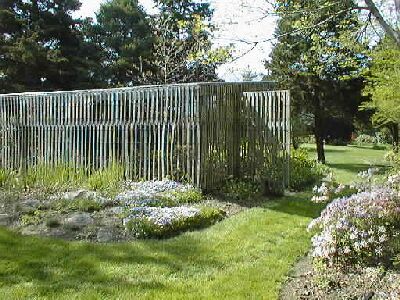James Powell Huie, Westport Point, MA
A lath house is a valuable asset in raising seedlings, rooted cuttings, and young rhododendron plants prior to setting them out in the garden. Properly used, it will modify the environment in which they are growing by offering protection from hot, drying summer winds, reducing the intensity of the sunlight, lowering temperatures, and by maintaining a higher humidity. During December, January and February, the sides may be covered by plastic sheeting, which will furnish additional protection from the winter cold.

The lath house here in Westport Point is simply a framework of treated lumber covered with snow fencing. The corner posts are 4"X4"s, and the remainder of the framework 2"X6"s and 2"X4"s. If you decide to build a lath house, it is suggested that a sketch be made first, taking into consideration the width of the snow fencing, location of a door, etc. Be certain there is enough headroom. The first one I built was only five feet in height, but eventually was replaced by one having a minimum height of six and one-half feet, which is much easier to work in. It was also found that in order to provide enough shade, two layers of snow fencing was necessary on the roof, a layer running in one direction and a second layer at right angles to it.
After using the second lath house for about a year, it was apparent that additional shade was needed. The roof was first covered with black shade cloth, a total disaster because the black cloth absorbed heat from the sun, making it hotter inside the lath house than out in the full sun. Fortunately, I then was able to locate a shade cloth made of woven strips of plastic and treated aluminum, which reflects the sun's rays and gives the effect of high shade inside the house. This cloth is left on in winter and, with the plastic sheeting on the sides, it gives added protection to the plants. However, a word of caution if the cloth is not removed in winter. In this case, some support must be provided inside the house for the rafters or roofing joists, using vertical 2"X4"s, because a heavy, wet snow fall could pile up on the roof and bring the entire structure down.
In summer, air should be allowed to circulate freely through the lath house in order to keep temperatures down, and therefore, large plants must be kept at some distance. If plastic sheeting is used on the sides of the house during winter, it must be removed as soon as the worst of the cold weather is over. After a couple of years of experience, I decided to install a misting system, which serves a dual purpose of both irrigating and keeping the plants cool on very warm days.

Almost all of the plants now in the lath house in Westport are species from the Rhododendron Species Foundation. On arrival, they were tagged with their names, source, and year of purchase, using aluminum tape tied to the plants with plastic covered bell wire. Since it was not possible to set them out in the lath house immediately on their arrival, they were placed for a day or so in the house under the misting system. Planting was done later in a mix of rotted pine bark and a small amount of soil, plants watered, and then misted about every other day. Very few plants have been lost in this way. The only fertilizer used is a very small, almost minute amount of superphosphate to encourage root growth; never any nitrogen. All the plants, including hybrids, do just as well without adding nitrogen, which, I might add, is actually resented by many of the species. At this stage in the life of the plants, it is essential to keep the bark-soil mixture moist at all times. Never let it dry out.
The plants will be in the lath house for at least one year, or possibly two or three, depending on their rate of growth. The goal is to give them a needed helping hand until they are well established, and have larger, healthy root balls before being moved to the garden. In the garden the plants should continue to be treated as if they were in a nursery until they are able to take care of themselves.
Use a design of any shape or size for your lath house, keeping in mind the finished product must furnish enough shade and good air circulation. Many uses will be found for it, such as raising young nursery plants as well as those in containers, starting seeds and cuttings, and as a location for house plants which normally are moved outside during the summer.